中央处理器设计 外文翻译
- 格式:doc
- 大小:310.00 KB
- 文档页数:20
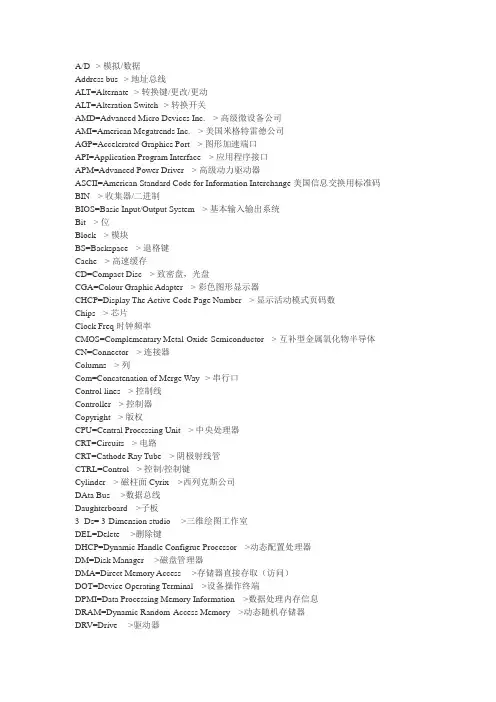
A/D--> 模拟/数据Address bus--> 地址总线ALT=Alternate--> 转换键/更改/更动ALT=Alteration Switch--> 转换开关AMD=Advanced Micro Devices Inc. --> 高级微设备公司AMI=American Megatrends Inc. --> 美国米格特雷德公司AGP=Accelerated Graphics Port --> 图形加速端口API=Application Program Interface --> 应用程序接口APM=Advanced Power Driver --> 高级动力驱动器ASCII=American Standard Code for Information Interchange 美国信息交换用标准码BIN --> 收集器/二进制BIOS=Basic Input/Output System --> 基本输入输出系统Bit --> 位Block --> 模块BS=Backspace --> 退格键Cache --> 高速缓存CD=Compact Disc --> 致密盘,光盘CGA=Colour Graphic Adapter --> 彩色图形显示器CHCP=Display The Active Code Page Number --> 显示活动模式页码数Chips --> 芯片Clock Freq 时钟频率CMOS=Complementary Metal-Oxide-Semiconductor --> 互补型金属氧化物半导体CN=Connector --> 连接器Columns --> 列Com=Concatenation of Merge Way--> 串行口Control lines --> 控制线Controller --> 控制器Copyright --> 版权CPU=Central Processing Unit --> 中央处理器CRT=Circuits --> 电路CRT=Cathode Ray Tube --> 阴极射线管CTRL=Control --> 控制/控制键Cylinder --> 磁柱面Cyrix--->西列克斯公司DAta Bus --->数据总线Daughterboard--->子板3 -Ds= 3-Dimension studio --->三维绘图工作室DEL=Delete --->删除键DHCP=Dynamic Handle Configrue Processor--->动态配置处理器DM=Disk Manager --->磁盘管理器DMA=Direct Memory Access --->存储器直接存取(访问)DOT=Device Operating Terminal--->设备操作终端DPMI=Data Processing Memory Information--->数据处理内存信息DRAM=Dynamic Random-Access Memory--->动态随机存储器DRV=Drive --->驱动器DSP=Digital Signal Processor --->数字信号处理器EGA=Enhanced Graphic Adapter--->增强型图形显示器EMM=Expanded Memory Management--->扩展内存管理EMS=Expanded Memory System --->扩展内存系统EMS=Expanded Memory Specification --->扩展内存规范Encoded Keyboard --->编码键盘EROM=Erasable Read Only Memory--->可擦除只读存储器ESC=Escape --->退出键/退出系统ESDI=Enhanced Small Device Interface--->增强型小型设备界面(接口)FDD=Floppy Disk Drive --->软驱FPU=Floating Point Unit --->浮点处理器(数学协处理器)GB=Gigabyte --->千兆字节Gold Finger--->金插脚HDD=Hard Disk Light-emitting diode--->硬盘指示灯(发光二极管)Head--->磁头HPM=Hyper-Page-Mode--->超页模式IBM=International Business Machines Corporation--->国际商业机器公司ID=Identifier--->标识符ID=Inside Diameter--->内径IDE=Insede Diameter Enhanced--->内部直径增强接口INS=Insert--->插入行/插入键Intel--->英特尔公司Interleave--->交叉(存取)因子Intersections--->内部结点I/O=Input/Output---->输入输出IRC=Interrupt Controller--->中断控制IRQ=Interrupt Require --->中断请求Joysticks--->操纵杆JP(Jumper)--->跳线JCP=Jumper Channel Port--->跳通道线端KB=Kilobytes--->千字节KB=Keyboard--->键盘Land Zone Cylinder--->焊盘存储区磁柱面LASER=Light Amplification By Stimulation Emission Of Eadiation--->激光/镭射LPT=Line Parrallel Tandem--->并行口Mainboard--->主板MAP=Microprocessor Application Project--->微处理机应用计划Master Clock--->主时钟MCI=Media Control Interface--->媒体控制接口MIDI=Musecal Instrument Digital Interface--->乐器数字接口Modem=Modulator and Demodulator--->调制解调器Motherboard--->母板MPU=Micro-Processor(Processing) Unit--->微处理器MS=Microsoft---->微软MS=Memory System/Main Storage--->内存/主存NMOS=Negative Metal-Oxide-Semiconductor--->阴极金属氧化物半导体NT=New Technology--->新技术NTAS=New Technology Advanced Server--->新技术超级服务器NTFS=New Technology File System--->新科技文件系统PC=Private Compatible Machine--->个人兼容机PCI=Peripheral Component Interconnect--->外围元件互连PDI=Program Device Information--->程序设备信息PDQ=Parrallel Data Query--->并行数据查询Peripherals--->外设PgDn=Page Down--->向下翻页PgUp=Page Up--->向上翻页Pins--->插脚PMOS=Positive Metal-Oxide-Semiconductor--->阳极金属氧化物半导体Power--->电源Precompensation Cylinder--->预补偿磁柱面Printer--->打印机/打印PROM=Programmable Read Only Memory--->可编程序只读存储器RAM=Random-Access Memory--->随机存储器/内存RBS=Remote Boot Service--->远程引导(启动)服务Regulator--->调整器Reset--->复位/复位键REV.=Revision--->版本号RISC=Reduced Instruction Set Computer--->精减指令集计算机系统ROM=Read Only Memory--->只读存储器Rows--->行RTC=Real Time Clock--->实时钟SB=Sound Blaster--->有声装置/声卡SCSI=Small Computer System Interface--->小型计算机系统界面(接口)Sector--->扇区Selector--->选择器SFT=Shifter--->换档键SIMM(Single-In-Line Memory Modules)--->单列直插式内存模块SL=Slot--->插槽SMM(System Management Mode)--->系统管理模式SPK=Speaker--->喇叭SRAM(System Random Access Memory)--->系统随机访问存储器SW=Switch--->开关SYS=System--->系统Tag RAM--->标记随机存储器TM=Trade Mark--->商标Track--->磁道UPS=Uninterruptible Power System--->连续供电电源系统UPS=Uninterruptible Power Supply--->不间断供电电源VB=Vision Blaster--->视霸卡VCC=Volt Current Condenser--->电源电位Video Display Generator--->视频显示器VGA=Video Graphic Adapter--->视频图形显示器计算机常用英语术语、词汇表Computer Vocabulary In Common Use一、硬件类(Hardware)二、软件类(Software)三、网络类(Network)四、其它CPU(Center Processor Unit)中央处理单元mainboard主板RAM(random accessmemory)随机存储器(内存)ROM(Read Only Memory)只读存储器Floppy Disk软盘Hard Disk硬盘CD-ROM光盘驱动器(光驱)monitor监视器keyboard键盘mouse鼠标chip芯片CD-R光盘刻录机HUB集线器Modem= MOdulator-DEModulator,调制解调器P-P(Plug and Play)即插即用UPS(Uninterruptable Power Supply)不间断电源BIOS(Basic-input-OutputSystem)基本输入输出系统CMOS(Complementary Metal-Oxide-Semiconductor)互补金属氧化物半导体setup安装uninstall卸载wizzard向导OS(Operation Systrem)操作系统OA(Office AutoMation)办公自动化exit退出edit编辑copy复制cut剪切paste粘贴delete删除select选择find查找select all全选replace替换undo撤消redo重做program程序license许可(证)back前一步next下一步finish结束folder文件夹Destination Folder目的文件夹user用户click点击double click双击right click右击settings设置update更新release发布data数据data base数据库DBMS(Data Base ManegeSystem)数据库管理系统view视图insert插入object对象configuration配置command命令document文档POST(power-on-self-test)电源自检程序cursor光标attribute属性icon图标service pack服务补丁option pack功能补丁Demo演示short cut快捷方式exception异常debug调试previous前一个column行row列restart重新启动text文本font字体size大小scale比例interface界面function函数access访问manual指南active激活computer language计算机语言menu菜单GUI(graphical userinterfaces )图形用户界面template模版page setup页面设置password口令code密码print preview打印预览zoom in放大zoom out缩小pan漫游cruise漫游full screen全屏tool bar工具条status bar状态条ruler标尺table表paragraph段落symbol符号style风格execute执行graphics图形image图像Unix用于服务器的一种操作系统Mac OS苹果公司开发的操作系统OO(Object-Oriented)面向对象virus病毒file文件open打开colse关闭new新建save保存exit退出clear清除default默认LAN局域网WAN广域网Client/Server客户机/服务器ATM( AsynchronousTransfer Mode)异步传输模式Windows NT微软公司的网络操作系统Internet互联网WWW(World Wide Web)万维网protocol协议HTTP超文本传输协议FTP文件传输协议Browser浏览器homepage主页Webpage网页website网站URL在Internet的WWW服务程序上用于指定信息位置的表示方法Online在线Email电子邮件ICQ网上寻呼Firewall防火墙Gateway网关HTML超文本标识语言hypertext超文本hyperlink超级链接IP(Address)互联网协议(地址)SearchEngine搜索引擎TCP/IP用于网络的一组通讯协议Telnet远程登录IE(Internet Explorer)探索者(微软公司的网络浏览器) Navigator引航者(网景公司的浏览器)multimedia多媒体ISO国际标准化组织ANSI美国国家标准协会able 能activefile 活动文件addwatch 添加监视点allfiles 所有文件allrightsreserved 所有的权力保留altdirlst 切换目录格式andfixamuchwiderrangeofdiskproblems 并能够解决更大范围内的磁盘问题andotherinFORMation 以及其它的信息archivefileattribute 归档文件属性assignto 指定到autoanswer 自动应答autodetect 自动检测autoindent 自动缩进autosave 自动存储availableonvolume 该盘剩余空间badcommand 命令错badcommandorfilename 命令或文件名错batchparameters 批处理参数binaryfile 二进制文件binaryfiles 二进制文件borlandinternational borland国际公司bottommargin 页下空白bydate 按日期byextension 按扩展名byname 按名称bytesfree 字节空闲callstack 调用栈casesensitive 区分大小写causespromptingtoconfirmyouwanttooverwritean 要求出现确认提示,在你想覆盖一个centralpointsoftwareinc central point 软件股份公司changedirectory 更换目录changedrive 改变驱动器changename 更改名称characterset 字符集checkingfor 正在检查checksadiskanddisplaysastatusreport 检查磁盘并显示一个状态报告chgdrivepath 改变盘/路径china 中国chooseoneofthefollowing 从下列中选一项clearall 全部清除clearallbreakpoints 清除所有断点clearsanattribute 清除属性clearscommandhistory 清除命令历史clearscreen 清除屏幕closeall 关闭所有文件codegeneration 代码生成colorpalette 彩色调色板commandline 命令行commandprompt 命令提示符compressedfile 压缩文件configuresaharddiskforusewithmsdos 配置硬盘,以为 MS-DOS 所用conventionalmemory 常规内存copiesdirectoriesandsubdirectoriesexceptemptyones 拷贝目录和子目录,空的除外copiesfileswiththearchiveattributeset 拷贝设置了归档属性的文件copiesoneormorefilestoanotherlocation 把文件拷贝或搬移至另一地方copiesthecontentsofonefloppydisktoanother 把一个软盘的内容拷贝到另一个软盘上copydiskette 复制磁盘copymovecompfindrenamedeletevervieweditattribwordpprintlist C拷贝M移动 O比 F搜索R改名 D删除 V版本 E浏览A属性 W写字 P打印 L列表copyrightc 版权(ccreatedospartitionorlogicaldosdrive 创建DOS分区或逻辑DOS驱动器createextendeddospartition 创建扩展DOS分区createlogicaldosdrivesintheextendeddospartition 在扩展DOS分区中创建逻辑DOS驱动器createprimarydospartition 创建DOS主分区createsadirectory 创建一个目录createschangesordeletesthevolumelabelofadisk 创建,改变或删除磁盘的卷标currentfile 当前文件currentfixeddiskdrive 当前硬盘驱动器currentsettings 当前设置currenttime 当前时间cursorposition 光标位置defrag 整理碎片dele 删去deletepartitionorlogicaldosdrive 删除分区或逻辑DOS驱动器deletesadirectoryandallthesubdirectoriesandfilesinit 删除一个目录和所有的子目录及其中的所有文件deltree 删除树devicedriver 设备驱动程序dialogbox 对话栏directionkeys 方向键directly 直接地directorylistargument 目录显示变量directoryof 目录清单directorystructure 目录结构diskaccess 磁盘存取diskcopy 磁盘拷贝diskservicescopycomparefindrenameverifyvieweditmaplocateinitialize 磁盘服务功能: C拷贝 O 比较 F搜索R改卷名V校验浏览E编缉M图 L找文件 N格式化diskspace 磁盘空间displayfile 显示文件displayoptions 显示选项displaypartitioninFORMation 显示分区信息displaysfilesinspecifieddirectoryandallsubdirectories 显示指定目录和所有目录下的文件displaysfileswithspecifiedattributes 显示指定属性的文件displaysorchangesfileattributes 显示或改变文件属性displaysorsetsthedate 显示或设备日期displayssetupscreensinmonochromeinsteadofcolor 以单色而非彩色显示安装屏信息displaystheamountofusedandfreememoryinyoursystem 显示系统中已用和未用的内存数量displaysthefullpathandnameofeveryfileonthedisk 显示磁盘上所有文件的完整路径和名称displaysthenameoforchangesthecurrentdirectory 显示或改变当前目录doctor 医生doesn 不doesntchangetheattribute 不要改变属性dosshell DOS 外壳doubleclick 双击doyouwanttodisplaythelogicaldriveinFORMationyn 你想显示逻辑驱动器信息吗(y/n)? driveletter 驱动器名editmenu 编辑选单emsmemory ems内存endoffile 文件尾endofline 行尾enterchoice 输入选择entiredisk 转换磁盘environmentvariable 环境变量esc esceveryfileandsubdirectory 所有的文件和子目录existingdestinationfile 已存在的目录文件时expandedmemory 扩充内存expandtabs 扩充标签explicitly 明确地extendedmemory 扩展内存fastest 最快的fatfilesystem fat 文件系统fdiskoptions fdisk选项fileattributes 文件属性fileFORMat 文件格式filefunctions 文件功能fileselection 文件选择fileselectionargument 文件选择变元filesin 文件在filesinsubdir 子目录中文件fileslisted 列出文件filespec 文件说明filespecification 文件标识filesselected 选中文件findfile 文件查寻fixeddisk 硬盘fixeddisksetupprogram 硬盘安装程序fixeserrorsonthedisk 解决磁盘错误floppydisk 软盘FORMatdiskette 格式化磁盘FORMatsadiskforusewithmsdos 格式化用于MS-DOS的磁盘FORMfeed 进纸freememory 闲置内存fullscreen 全屏幕functionprocedure 函数过程graphical 图解的graphicslibrary 图形库groupdirectoriesfirst 先显示目录组hangup 挂断harddisk 硬盘hardwaredetection 硬件检测hasbeen 已经helpfile 帮助文件helpindex 帮助索引helpinFORMation 帮助信息helppath 帮助路径helpscreen 帮助屏helptext 帮助说明helptopics 帮助主题helpwindow 帮助窗口hiddenfile 隐含文件hiddenfileattribute 隐含文件属性hiddenfiles 隐含文件howto 操作方式ignorecase 忽略大小写inbothconventionalanduppermemory 在常规和上位内存incorrectdos 不正确的DOSincorrectdosversion DOS 版本不正确indicatesabinaryfile 表示是一个二进制文件indicatesanasciitextfile 表示是一个ascii文本文件insertmode 插入方式insteadofusingchkdsktryusingscandisk 请用scandisk,不要用chkdsk inuse 在使用invaliddirectory 无效的目录is 是kbytes 千字节keyboardtype 键盘类型labeldisk 标注磁盘laptop 膝上largestexecutableprogram 最大可执行程序largestmemoryblockavailable 最大内存块可用lefthanded 左手习惯leftmargin 左边界linenumber 行号linenumbers 行号linespacing 行间距listbyfilesinsortedorder 按指定顺序显示文件listfile 列表文件listof 清单locatefile 文件定位lookat 查看lookup 查找macroname 宏名字makedirectory 创建目录memoryinfo 内存信息memorymodel 内存模式menubar 菜单条menucommand 菜单命令menus 菜单messagewindow 信息窗口microsoft 微软microsoftantivirus 微软反病毒软件microsoftcorporation 微软公司mini 小的modemsetup 调制解调器安装modulename 模块名monitormode 监控状态monochromemonitor 单色监视器moveto 移至multi 多newdata 新建数据newer 更新的newfile 新文件newname 新名称newwindow 新建窗口norton nortonnostack 栈未定义noteusedeltreecautiously 注意:小心使用deltree onlinehelp 联机求助optionally 可选择地or 或pageframe 页面pagelength 页长pausesaftereachscreenfulofinFORMation 在显示每屏信息后暂停一下pctools pc工具postscript 附言prefixmeaningnot 前缀意即"不prefixtoreverseorder 反向显示的前缀presetswitchesbyprefixinganyswitchwithhyphenforexamplew 用前缀和放在短横线-后的开关(例如/-w)预置开关pressakeytoresume 按一键继续pressanykeyforfilefunctions 敲任意键执行文件功能pressentertokeepthesamedate 敲回车以保持相同的日期pressentertokeepthesametime 敲回车以保持相同的时间pressesctocontinue 敲esc继续pressesctoexit 敲<esc>键退出pressesctoexitfdisk 敲esc退出fdiskpressesctoreturntofdiskoptions 敲esc返回fdisk选项previously 在以前printall 全部打印printdevice 打印设备printerport 打印机端口processesfilesinalldirectoriesinthespecifiedpath 在指定的路径下处理所有目录下的文件programfile 程序文件programmingenvironment 程序设计环境promptsyoubeforecreatingeachdestinationfile 在创建每个目标文件时提醒你promptsyoutopressakeybeforecopying 在拷贝前提示你敲一下键pulldown 下拉pulldownmenus 下拉式选单quickFORMat 快速格式化quickview 快速查看readonlyfile 只读文件readonlyfileattribute 只读文件属性readonlyfiles 只读文件readonlymode 只读方式redial 重拨repeatlastfind 重复上次查找reportfile 报表文件resize 调整大小respectively 分别地rightmargin 右边距rootdirectory 根目录runsdebugaprogramtestingandeditingtool 运行debug, 它是一个测试和编辑工具runtimeerror 运行时出错saveall 全部保存saveas 另存为scandisk 磁盘扫描程序scandiskcanreliablydetect scandisk可以可靠地发现screencolors 屏幕色彩screenoptions 屏幕任选项screensaver 屏幕暂存器screensavers 屏幕保护程序screensize 屏幕大小scrollbars 翻卷栏scrolllockoff 滚屏已锁定searchfor 搜索sectorspertrack 每道扇区数selectgroup 选定组selectionbar 选择栏setactivepartition 设置活动分区setupoptions 安装选项shortcutkeys 快捷键showclipboard 显示剪贴板singleside 单面sizemove 大小/移动sorthelp S排序H帮助sortorder 顺序specialservicesdirectorymaint 特殊服务功能: D目录维护specifiesdrivedirectoryandorfilestolist 指定要列出的驱动器,目录,和文件specifiesthatyouwanttochangetotheparentdirectory 指定你想把父目录作为当前目录specifiesthedirectoryandorfilenameforthenewfile 指定新文件的目录或文件名specifiesthefileorfilestobecopied 指定要拷贝的文件stackoverflow 栈溢出standalone 独立的startupoptions 启动选项statusline 状态行stepover 单步summaryof 摘要信息suppressespromptingtoconfirmyouwanttooverwritean 取消确认提示,在你想覆盖一个swapfile 交换文件switchesmaybepresetinthedircmdenvironmentvariable 开关可在dircmd环境变量中设置switchto 切换到sync 同步systemfile 系统文件systemfiles 系统文件systeminfo 系统信息systeminFORMation 系统信息程序tableofcontents 目录terminalemulation 终端仿真terminalsettings 终端设置testfile 测试文件testfileparameters 测试文件参数theactivewindow 激活窗口theswitchymaybepresetinthecopycmdenvironmentvariable /y开关可以在copycmd环境变量中预置thetwofloppydisksmustbethesametype 两个软磁盘必须是同种类型的thismaybeoverriddenwithyonthecommandline 在命令行输入/-y可以使之无效togglebreakpoint 切换断点tomsdos 转到MS-DOStopmargin 页面顶栏turnoff 关闭typecddrivetodisplaythecurrentdirectoryinthespecifieddrive 键入cd驱动器:显示指定驱动器的当前目录typecdwithoutparameterstodisplaythecurrentdriveanddirectory 键入无参数的cd以显示当前驱动器的当前目录typedatewithoutparameterstodisplaythecurrentdatesettingand 键入无参数的date,显示当前日期设置和unmark 取消标记unselect 取消选择usesbareFORMat 使用简洁方式useslowercase 使用小写useswidelistFORMat 使用宽行显示usinghelp 使用帮助verbosely 冗长地verifiesthatnewfilesarewrittencorrectly 校验新文件是否正确写入了videomode 显示方式viewwindow 内容浏览viruses 病毒vision 景象vollabel 卷标volumelabel 卷标volumeserialnumberis 卷序号是windowshelp windows 帮助wordwrap 整字换行workingdirectory 正在工作的目录worm 蠕虫writemode 写方式writeto 写到xmsmemory 扩充内存youmay 你可以我把网络安全方面的专业词汇整理了一下,虽然大多是乱谈,但初衷在于初学者能更好的了解这些词汇。
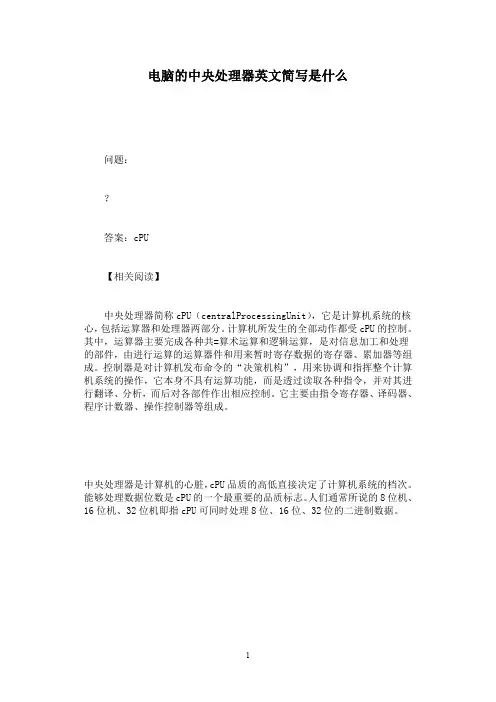
电脑的中央处理器英文简写是什么
问题:
?
答案:cPU
【相关阅读】
中央处理器简称cPU(centralProcessingUnit),它是计算机系统的核心,包括运算器和处理器两部分。
计算机所发生的全部动作都受cPU的控制。
其中,运算器主要完成各种共=算术运算和逻辑运算,是对信息加工和处理的部件,由进行运算的运算器件和用来暂时寄存数据的寄存器、累加器等组成。
控制器是对计算机发布命令的“决策机构”,用来协调和指挥整个计算机系统的操作,它本身不具有运算功能,而是透过读取各种指令,并对其进行翻译、分析,而后对各部件作出相应控制。
它主要由指令寄存器、译码器、程序计数器、操作控制器等组成。
中央处理器是计算机的心脏,cPU品质的高低直接决定了计算机系统的档次。
能够处理数据位数是cPU的一个最重要的品质标志。
人们通常所说的8位机、16位机、32位机即指cPU可同时处理8位、16位、32位的二进制数据。
1。
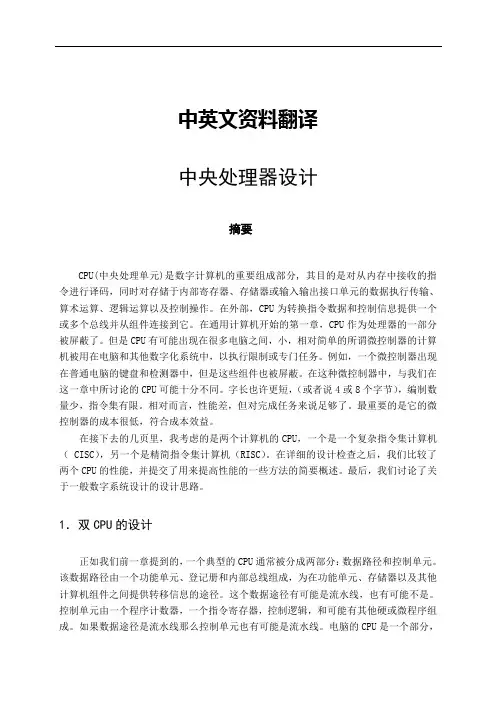
中英文资料翻译中央处理器设计摘要CPU(中央处理单元)是数字计算机的重要组成部分,其目的是对从内存中接收的指令进行译码,同时对存储于内部寄存器、存储器或输入输出接口单元的数据执行传输、算术运算、逻辑运算以及控制操作。
在外部,CPU为转换指令数据和控制信息提供一个或多个总线并从组件连接到它。
在通用计算机开始的第一章,CPU作为处理器的一部分被屏蔽了。
但是CPU有可能出现在很多电脑之间,小,相对简单的所谓微控制器的计算机被用在电脑和其他数字化系统中,以执行限制或专门任务。
例如,一个微控制器出现在普通电脑的键盘和检测器中,但是这些组件也被屏蔽。
在这种微控制器中,与我们在这一章中所讨论的CPU可能十分不同。
字长也许更短,(或者说4或8个字节),编制数量少,指令集有限。
相对而言,性能差,但对完成任务来说足够了。
最重要的是它的微控制器的成本很低,符合成本效益。
在接下去的几页里,我考虑的是两个计算机的CPU,一个是一个复杂指令集计算机( CISC),另一个是精简指令集计算机(RISC)。
在详细的设计检查之后,我们比较了两个CPU的性能,并提交了用来提高性能的一些方法的简要概述。
最后,我们讨论了关于一般数字系统设计的设计思路。
1.双CPU的设计正如我们前一章提到的,一个典型的CPU通常被分成两部分:数据路径和控制单元。
该数据路径由一个功能单元、登记册和内部总线组成,为在功能单元、存储器以及其他计算机组件之间提供转移信息的途径。
这个数据途径有可能是流水线,也有可能不是。
控制单元由一个程序计数器,一个指令寄存器,控制逻辑,和可能有其他硬或微程序组成。
如果数据途径是流水线那么控制单元也有可能是流水线。
电脑的CPU是一个部分,要么是复杂指令集计算机( CISC),要么是精简指令集计算机(RISC),有自己的指令集架构。
本章的目的是提交两个CPU的设计,用来说明指令集,数据路径,和控制单元的构造特征的合并。
该设计将自上而下,但随着先前组件设计的重新使用,来说明指令集构架在数据路径和控制单元上的影响,数据路径上的单元的影响力。
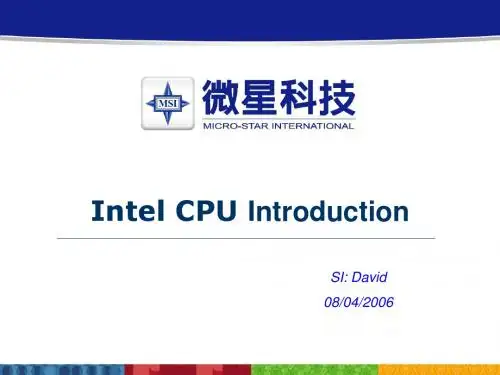
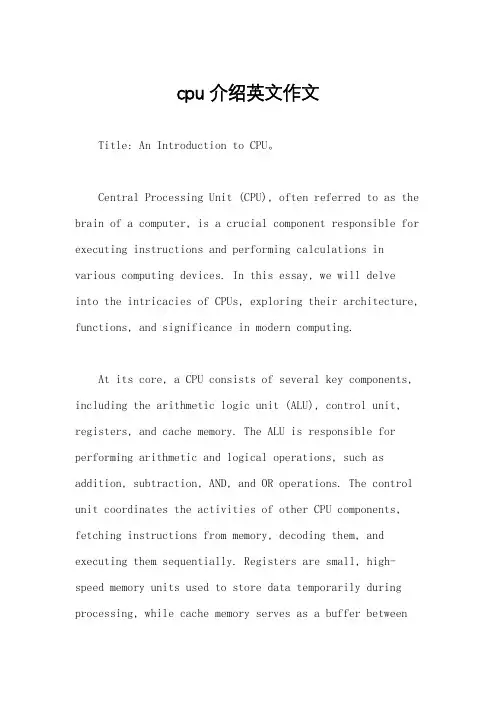
cpu介绍英文作文Title: An Introduction to CPU。
Central Processing Unit (CPU), often referred to as the brain of a computer, is a crucial component responsible for executing instructions and performing calculations in various computing devices. In this essay, we will delveinto the intricacies of CPUs, exploring their architecture, functions, and significance in modern computing.At its core, a CPU consists of several key components, including the arithmetic logic unit (ALU), control unit, registers, and cache memory. The ALU is responsible for performing arithmetic and logical operations, such as addition, subtraction, AND, and OR operations. The control unit coordinates the activities of other CPU components, fetching instructions from memory, decoding them, and executing them sequentially. Registers are small, high-speed memory units used to store data temporarily during processing, while cache memory serves as a buffer betweenthe CPU and the main memory, speeding up data access.CPU architecture varies across different devices and manufacturers, but they typically follow the Von Neumann architecture, named after the renowned mathematician and computer scientist John von Neumann. This architecture comprises a CPU, memory, input/output (I/O) devices, and a system bus that facilitates communication between these components. The CPU interacts with memory to fetch instructions and data, processes them, and then sends the results back to memory or to the I/O devices for further action.One of the most crucial aspects of CPU design is its instruction set architecture (ISA), which defines the set of instructions that the CPU can execute. Common ISAs include Reduced Instruction Set Computing (RISC) and Complex Instruction Set Computing (CISC). RISC CPUs typically have a smaller set of simple instructions, favoring simpler designs and faster execution, while CISC CPUs support a broader range of complex instructions, potentially reducing the number of instructions needed toperform a task.In addition to ISA, CPU performance is influenced by factors such as clock speed, pipelining, and parallelism. Clock speed, measured in gigahertz (GHz), determines how many instructions a CPU can execute per second. Higherclock speeds generally result in faster processing, butother factors also play a role in overall performance. Pipelining allows multiple instructions to be processed simultaneously by dividing the execution process into discrete stages, while parallelism involves executing multiple instructions concurrently using multiple cores or threads.Multi-core CPUs have become increasingly prevalent in modern computing devices, with dual-core, quad-core, and even octa-core processors commonly found in smartphones, tablets, laptops, and desktop computers. Multi-core CPUs improve performance by distributing tasks across multiple cores, enabling better multitasking and parallel processing. Hyper-threading, a technology developed by Intel, allows each CPU core to execute multiple threads simultaneously,further enhancing performance in multithreaded applications.The significance of CPUs in modern computing cannot be overstated. From powering personal computers and servers to controlling embedded systems and mobile devices, CPUs form the backbone of digital technology. The relentless pursuitof faster, more efficient CPUs drives innovation in the semiconductor industry, leading to advancements in performance, power efficiency, and functionality.In conclusion, the CPU is a fundamental component of computing devices, responsible for executing instructions and performing calculations. Its architecture, instruction set, and performance characteristics play a pivotal role in determining the overall computing experience. As technology continues to evolve, CPUs will undoubtedly remain at the forefront of innovation, shaping the future of computing.。
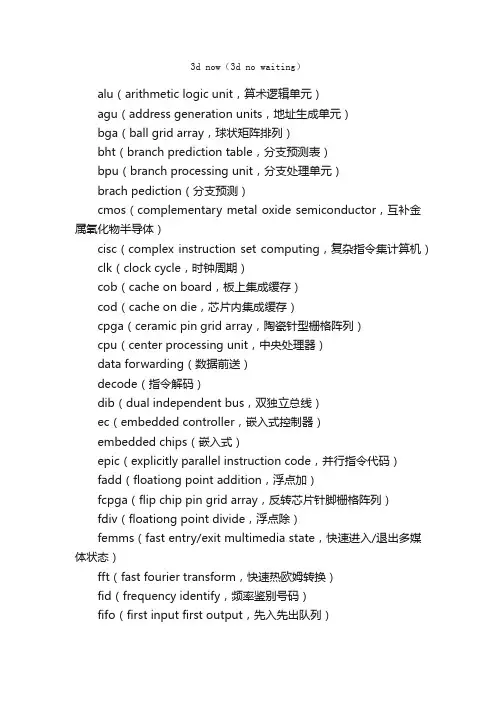
3d now(3d no waiting)alu(arithmetic logic unit,算术逻辑单元)agu(address generation units,地址生成单元)bga(ball grid array,球状矩阵排列)bht(branch prediction table,分支预测表)bpu(branch processing unit,分支处理单元)brach pediction(分支预测)cmos(complementary metal oxide semiconductor,互补金属氧化物半导体)cisc(complex instruction set computing,复杂指令集计算机)clk(clock cycle,时钟周期)cob(cache on board,板上集成缓存)cod(cache on die,芯片内集成缓存)cpga(ceramic pin grid array,陶瓷针型栅格阵列)cpu(center processing unit,中央处理器)data forwarding(数据前送)decode(指令解码)dib(dual independent bus,双独立总线)ec(embedded controller,嵌入式控制器)embedded chips(嵌入式)epic(explicitly parallel instruction code,并行指令代码)fadd(floationg point addition,浮点加)fcpga(flip chip pin grid array,反转芯片针脚栅格阵列)fdiv(floationg point divide,浮点除)femms(fast entry/exit multimedia state,快速进入/退出多媒体状态)fft(fast fourier transform,快速热欧姆转换)fid(frequency identify,频率鉴别号码)fifo(first input first output,先入先出队列)flip-chip(芯片反转)flop(floating point operations per second,浮点操作/秒)fmul(floationg point multiplication,浮点乘)fpu(float point unit,浮点运算单元)fsub(floationg point subtraction,浮点减)gvpp(generic visual perception processor,常规视觉处理器)hl-pbga(表面黏著高耐热、轻薄型塑胶球状矩阵封装)ia(intel architecture,英特尔架构)icu(instruction control unit,指令控制单元)id(identify,鉴别号码)idf(intel developer forum,英特尔开发者论坛)ieu(integer execution units,整数执行单元)imm(intel mobile module,英特尔移动模块)instructions cache(指令缓存)instruction coloring(指令分类)ipc(instructions per clock cycle,指令/时钟周期)isa(instruction set architecture,指令集架构)kni(katmai new instructions,katmai新指令集,即sse)latency(潜伏期)ldt(lightning data transport,闪电数据传输总线)local interconnect(局域互连)mesi(modified,exclusive,shared,invalid,修改、排除、共享、废弃)mmx(multimedia extensions,多媒体扩展指令集)mmu(multimedia unit,多媒体单元)mflops(million floationg point/second,每秒百万个浮点操作)mhz(million hertz,兆赫兹)mp(multi-processing,多重处理器架构)mps(multiprocessor specification,多重处理器规范)msrs(model-specific registers,特别模块寄存器)naoc(no-account overclock,无效超频)ni(non-intel,非英特尔)olga(organic land grid array,基板栅格阵列)ooo(out of order,乱序执行)pga(pin-grid array,引脚网格阵列,耗电大)pr(performance rate,性能比率)psn(processor serial numbers,处理器序列号)pib(processor in a box,盒装处理器)ppga(plastic pin grid array,塑胶针状矩阵封装)pqfp(plastic quad flat package,塑料方块平面封装)raw(read after write,写后读)register contention(抢占寄存器)register pressure(寄存器不足)register renaming(寄存器重命名)remark(芯片频率重标识)resource contention(资源冲突)retirement(指令引退)risc(reduced instruction set computing,精简指令集计算机)sec(single edge connector,单边连接器)shallow-trench isolation(浅槽隔离)simd(single instruction multiple data,单指令多数据流)sio2f(fluorided silicon oxide,二氧氟化硅)smi(system management interrupt,系统管理中断)smm(system management mode,系统管理模式)smp(symmetric multi-processing,对称式多重处理架构)soi(silicon-on-insulator,绝缘体硅片)sonc(system on a ahip,系统集成芯片)spec(system performance evaluation corporation,系统性能评估测试)sqrt(square root calculations,平方根计算)sse(streaming simd extensions,单一指令多数据流扩展)superscalar(超标量体系结构)tcp(tape carrier package,薄膜封装,发热小)throughput(吞吐量)tlb(translate look ide buffers,翻译旁视缓冲器)uswc(uncacheabled speculative write combination,无缓冲随机联合写操作)valu(vector arithmetic logic unit,向量算术逻辑单元)vliw(very long instruction word,超长指令字)vpu(vector permutate unit,向量排列单元)vpu(vector processing units,向量处理单元,即处理mmx、sse等simd指令的地方)。
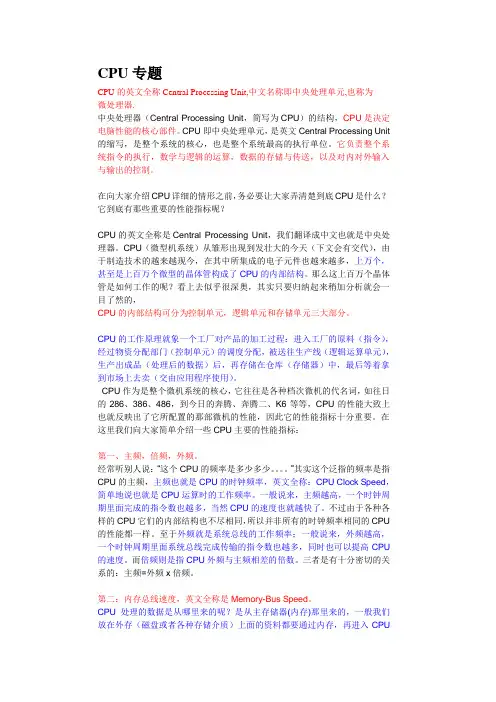
CPU专题CPU的英文全称Central Processing Unit,中文名称即中央处理单元,也称为微处理器.中央处理器(Central Processing Unit,简写为CPU)的结构,CPU是决定电脑性能的核心部件。
CPU即中央处理单元,是英文Central Processing Unit 的缩写,是整个系统的核心,也是整个系统最高的执行单位。
它负责整个系统指令的执行,数学与逻辑的运算,数据的存储与传送,以及对内对外输入与输出的控制。
在向大家介绍CPU详细的情形之前,务必要让大家弄清楚到底CPU是什么?它到底有那些重要的性能指标呢?CPU的英文全称是Central Processing Unit,我们翻译成中文也就是中央处理器。
CPU(微型机系统)从雏形出现到发壮大的今天(下文会有交代),由于制造技术的越来越现今,在其中所集成的电子元件也越来越多,上万个,甚至是上百万个微型的晶体管构成了CPU的内部结构。
那么这上百万个晶体管是如何工作的呢?看上去似乎很深奥,其实只要归纳起来稍加分析就会一目了然的,CPU的内部结构可分为控制单元,逻辑单元和存储单元三大部分。
CPU的工作原理就象一个工厂对产品的加工过程:进入工厂的原料(指令),经过物资分配部门(控制单元)的调度分配,被送往生产线(逻辑运算单元),生产出成品(处理后的数据)后,再存储在仓库(存储器)中,最后等着拿到市场上去卖(交由应用程序使用)。
CPU作为是整个微机系统的核心,它往往是各种档次微机的代名词,如往日的286、386、486,到今日的奔腾、奔腾二、K6等等,CPU的性能大致上也就反映出了它所配置的那部微机的性能,因此它的性能指标十分重要。
在这里我们向大家简单介绍一些CPU主要的性能指标:第一、主频,倍频,外频。
经常听别人说:“这个CPU的频率是多少多少。
”其实这个泛指的频率是指CPU的主频,主频也就是CPU的时钟频率,英文全称:CPU Clock Speed,简单地说也就是CPU运算时的工作频率。
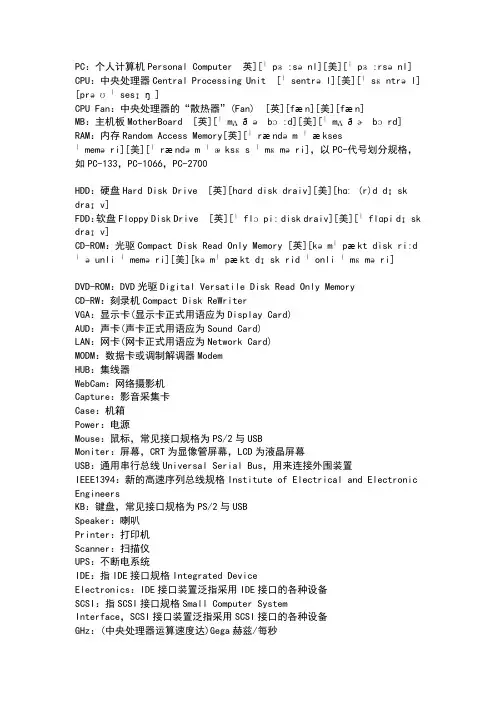
PC:个人计算机Personal Computer 英][ˈpɜ:sənl][美][ˈpɜ:rsənl] CPU:中央处理器Central Processing Unit [ˈsentrəl][美][ˈsɛntrəl] [prəʊˈsesɪŋ]CPU Fan:中央处理器的“散热器”(Fan) [英][fæn][美][fæn]MB:主机板MotherBoard [英][ˈmʌðə bɔ:d][美][ˈmʌðɚ bɔrd] RAM:内存Random Access Memory[英][ˈrændəm ˈæksesˈmeməri][美][ˈrændəm ˈæksɛs ˈmɛməri],以PC-代号划分规格,如PC-133,PC-1066,PC-2700HDD:硬盘Hard Disk Drive [英][hɑrd disk draiv][美][hɑː(r)d dɪsk draɪv]FDD:软盘Floppy Disk Drive [英][ˈflɔpi: disk draiv][美][ˈflɑpi dɪsk draɪv]CD-ROM:光驱Compact Disk Read Only Memory [英][kəmˈpækt disk ri:d ˈəunli ˈmeməri][美][kəmˈpækt dɪsk rid ˈonli ˈmɛməri]DVD-ROM:DVD光驱Digital Versatile Disk Read Only MemoryCD-RW:刻录机Compact Disk ReWriterVGA:显示卡(显示卡正式用语应为Display Card)AUD:声卡(声卡正式用语应为Sound Card)LAN:网卡(网卡正式用语应为Network Card)MODM:数据卡或调制解调器ModemHUB:集线器WebCam:网络摄影机Capture:影音采集卡Case:机箱Power:电源Mouse:鼠标,常见接口规格为PS/2与USBMoniter:屏幕,CRT为显像管屏幕,LCD为液晶屏幕USB:通用串行总线Universal Serial Bus,用来连接外围装置IEEE1394:新的高速序列总线规格Institute of Electrical and Electronic EngineersKB:键盘,常见接口规格为PS/2与USBSpeaker:喇叭Printer:打印机Scanner:扫描仪UPS:不断电系统IDE:指IDE接口规格Integrated DeviceElectronics:IDE接口装置泛指采用IDE接口的各种设备SCSI:指SCSI接口规格Small Computer SystemInterface,SCSI接口装置泛指采用SCSI接口的各种设备GHz:(中央处理器运算速度达)Gega赫兹/每秒FSB:指“前端总线(Front Side Bus)”频率,以MHz为单位ATA:指硬盘传输速率ATAttachment,ATA-133表示传输速率为133MB/secAGP:显示总线Accelerated GraphicsPort,以2X,4X,8X表示传输频宽模式PCI:外围装置连接端口Peripheral Component InterconnectATX:指目前电源供应器的规格,也指主机板标准大小尺寸BIOS:硬件(输入/输出)基本设置程序Basic Input Output System CMOS:储存BIOS基本设置数据的记忆芯片Complementary Metal-Oxide SemiconductorPOST:开机检测Power On Self TestOS:操作系统Operating SystemWindows:窗口操作系统,图形接口DOS:早期文字指令接口的操作系统 Disk Operating Systemfdisk:“规划硬盘扇区”-DOS指令之一format:“硬盘扇区格式化”-DOS指令之一:“执行安装程序”-DOS指令之一Socket:插槽,如CPU插槽种类有SocketA,Socket478等等Jumper:跳线(短路端子)Pin:针脚,如ATA133硬盘排线是80Pin,如PC2700内存模块是168Pin bit:位(0与1这两种电路状态),计算机数据最基本的单位Byte:字节,等于8 bit(八个位的组合,共有256种电路状态),计算机一个文字以8 bit来表示KB:等于1024 ByteMB:等于1024 KBGB:等于1024 MBaccess arm 磁头臂,存取臂access time 存取时间adder 加法器address 地址alphanumeric 字母数字的analog computer 模拟计算机analyst 分析员area 区域array 数组,阵列assembler 汇编程序automation 自动化band 区batch processing 成批处理binary code 二进制码binary digit 二进制位,二进制数字bit 比特,二进制的一位branch 分支,支线brush 电刷buffer storage 缓冲存储器calculator 计算器call instruction 呼叫指令card punch 卡片穿孔机card reader 卡片阅读机,读卡机cell 单元channel 通道,信道character 字符check digit 校验数位circuit 电路,线路to clear 清除,清零clock 时钟code 代码to code 编码coder 编码员,编码器command 指令,命令compiler 编译程序computer language 计算机语言console 控制台control unit 控制部件,控制器core storage, core store 磁心存储器counter 计数器cybernetics 控制论cycle 循环data 数据data processing 数据处理debugging 调试decision 制定digit 数字,数位,位digital computer 数字计算机disc, disk 磁盘display unit 显示装置drum 磁鼓to edit 编辑electronics 电子学emitter 发射器to encode 编码to erase 擦除,清洗,抹除feed 馈送,供给to feed 馈送,供给feedback 反馈field 字段,信息组,域file 文件floppy disk 软磁盘floppy disk drive 软磁盘机flow chart 流程图frame 帧hardware 硬件identifier 标识符index 索引information 信息inline processing 内处理input 输入inquiry 询问instruction 指令integrated circuit 集成电路to interpret 解释item 项目,项jump 转移key 键,关键码keyboard 键盘latency time 等待时间library 库,程序库linkage 连接to load 装入,寄存,写入,加载location 存储单元logger 登记器,记录器loop 循环machine language 机器语言magnetic storage 磁存储器magnetic tape 磁带matrix 矩阵memory 存储器message 信息,报文microcomputer 微型计算机module 组件,模块monitor 监视器,监督程序,管程nanosecond 毫微秒network 网络,网numeric, numerical 数字的,数值的octet 八位位组,八位字节operator 操作员optical character reader 光符阅读机optical scanner 光扫描器output 输出overflow 溢出,上溢panel 平板parameter 参数,参量perforator 穿孔机peripheral equipment 外围设备,外部设备personal computer 个人计算机printed circuit 印制电路printer 打印机printout 打印输出to process 处理processing unit 处理部件program 程序to program 程序编制programmer 程序设计员programming 程序设计,程序编制pulse 脉冲punch 穿孔to punch 穿孔punched card, punch card 穿孔卡片punched tape, punch tape 穿孔纸带punch hole 孔,穿孔random access 随机存取to read 读reader 阅读程序reading 阅读real time 实时record, register 记录redundancy 冗余routine 例行程序selector 选择器,选择符sentinel 标记sequence 序列,顺序sequential 顺序的serial 串行的.连续的shift 移位,移数signal 信号simulation 模拟simulator 模拟器,模拟程序software 软件,软设备sort 分类,排序sorter 分类人员,分类机,分类程序,排序程序storage 存储器to store 存储subroutine, subprogram 子程序switch 开关symbol 符号symbolic language 符号语言system 系统tabulator 制表机teleprinter 电传打字机terminal 终端terminal unit 终端设备timer 时钟,精密***time sharing 分时timing 定时track 磁道transducer 传感器,翻译机translator 翻译程序,翻译器to update 更新Winchester disk drive 温彻斯特磁盘机,硬盘机working storage 工作存储器PC:Personal Computer,个人计算机、个人电脑,又称微型计算机或微机。
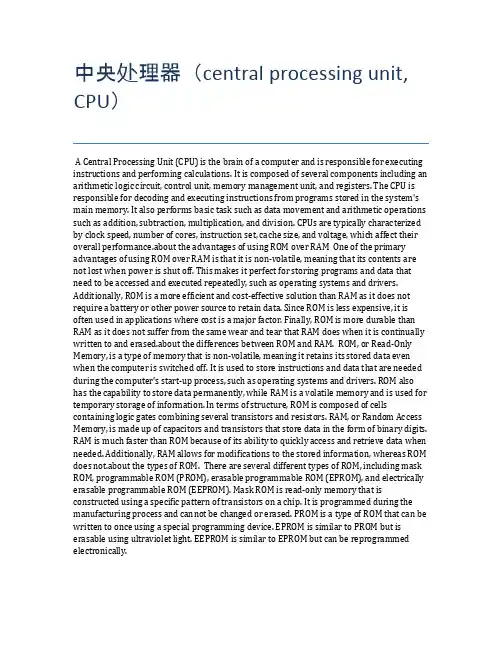
中央处理器(central processing unit, CPU)A Central Processing Unit (CPU) is the brain of a computer and is responsible for executing instructions and performing calculations. It is composed of several components including an arithmetic logic circuit, control unit, memory management unit, and registers. The CPU is responsible for decoding and executing instructions from programs stored in the system's main memory. It also performs basic task such as data movement and arithmetic operations such as addition, subtraction, multiplication, and division. CPUs are typically characterized by clock speed, number of cores, instruction set, cache size, and voltage, which affect their overall performance.about the advantages of using ROM over RAM One of the primary advantages of using ROM over RAM is that it is non-volatile, meaning that its contents are not lost when power is shut off. This makes it perfect for storing programs and data that need to be accessed and executed repeatedly, such as operating systems and drivers. Additionally, ROM is a more efficient and cost-effective solution than RAM as it does not require a battery or other power source to retain data. Since ROM is less expensive, it is often used in applications where cost is a major factor. Finally, ROM is more durable than RAM as it does not suffer from the same wear and tear that RAM does when it is continually written to and erased.about the differences between ROM and RAM. ROM, or Read-Only Memory, is a type of memory that is non-volatile, meaning it retains its stored data even when the computer is switched off. It is used to store instructions and data that are needed during the computer's start-up process, such as operating systems and drivers. ROM also has the capability to store data permanently, while RAM is a volatile memory and is used for temporary storage of information. In terms of structure, ROM is composed of cells containing logic gates combining several transistors and resistors. RAM, or Random Access Memory, is made up of capacitors and transistors that store data in the form of binary digits. RAM is much faster than ROM because of its ability to quickly access and retrieve data when needed. Additionally, RAM allows for modifications to the stored information, whereas ROM does not.about the types of ROM. There are several different types of ROM, including mask ROM, programmable ROM (PROM), erasable programmable ROM (EPROM), and electrically erasable programmable ROM (EEPROM). Mask ROM is read-only memory that is constructed using a specific pattern of transistors on a chip. It is programmed during the manufacturing process and cannot be changed or erased. PROM is a type of ROM that can be written to once using a special programming device. EPROM is similar to PROM but is erasable using ultraviolet light. EEPROM is similar to EPROM but can be reprogrammed electronically.。
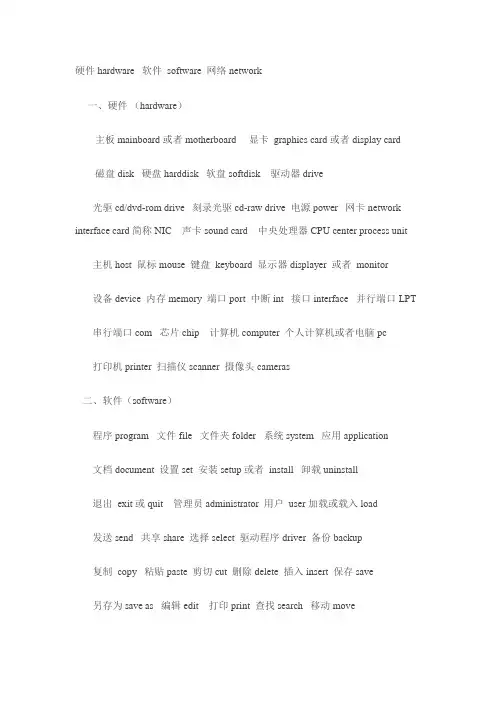
硬件 hardware 软件 software 网络 network一、硬件(hardware)主板 mainboard 或者 motherboard 显卡 graphics card 或者 display card磁盘 disk 硬盘 harddisk 软盘 softdisk 驱动器 drive光驱 cd/dvd-rom drive 刻录光驱cd-raw drive 电源 power 网卡 network interface card 简称 NIC 声卡 sound card 中央处理器 CPU center process unit 主机 host 鼠标 mouse 键盘 keyboard 显示器 displayer 或者 monitor设备 device 内存 memory 端口 port 中断 int 接口 interface 并行端口 LPT 串行端口 com 芯片 chip 计算机 computer 个人计算机或者电脑 pc打印机 printer 扫描仪 scanner 摄像头 cameras二、软件(software)程序 program 文件 file 文件夹 folder 系统 system 应用 application文档 document 设置 set 安装 setup 或者 install 卸载 uninstall退出 exit 或 quit 管理员 administrator 用户 user 加载或载入 load发送 send 共享 share 选择 select 驱动程序 driver 备份 backup复制 copy 粘贴 paste 剪切 cut 删除 delete 插入 insert 保存 save另存为 save as 编辑 edit 打印 print 查找 search 移动 move属性 property 打开 open 关闭 close 安全 security 工具 tool安全模式 safemodel 启动 boot 页面 page 病毒 virus 杀毒 kill virus查询 query 表单 table 追加 append 媒介 media 音量 volume重启 restart 或reboot 锁定 lock 格式化 format 分区 partition主引导记录 mbr 镜像 mirror 磁盘阵列 disk array 组 group 服务 sevice 桌面 desktop 运行 run 字体 font 屏幕 screen 地址 address 缓存 cacheram 读写存储器 rom 只读存储器 video 视频数据 data 检测 test 或 detect 访问 access 激活 active 配置 config 菜单 menu 标题 title 状态 status 三、网络 (network)调制解调器(俗称“猫”) modem 交换机 switcher 集线器 hub路由器 router 网卡 NIC局域网 local area network 简称 LAN城域网 metropolitan area network 简称 MAN广域网 WANWide Area Network 简称 WAN互联网 internet服务器 server 客户端 client 远程登陆 telnet 协议 potocol文件传输协议 file transfer protocol 简称 FTP超文件传输协议 hyper text transfer potocol 简称 HTTP简单传输协议 simple message transfer potocol 简称 SMTP传输控制协议 transmission control potocol 简称 TCP用户数据包协议 user datagram protocol简称 UDP动态域名服务器 dynamic domain server 简称 DNS动态主机配置服务器 dynamic host configuration potocol server 简称 DHCP无线 wireless 非屏弊双绞线 UTP 下载 download 上传 upload 连接connection通讯 communication 本地 local 远程 remote 网关 gateway 域名 domain 子网掩码 subnet mask 数据包 package 线路 line主板zhong3GIO(Third Generation Input/Output,第三代输入输出技术)ACR(Advanced Communications Riser,高级通讯升级卡)ADIMM(advanced Dual In-line Memory Modules,高级双重内嵌式内存模块)AGTL+(Assisted Gunning Transceiver Logic,援助发射接收逻辑电路)AHCI(Advanced Host Controller Interface,高级主机控制器接口)AIMM(AGP Inline Memory Module,AGP板上内存升级模块)AMR(Audio/Modem Riser;音效/调制解调器主机板附加直立插卡)AHA(Accelerated Hub Architecture,加速中心架构)AOI(Automatic Optical Inspection,自动光学检验)APU(Audio Processing Unit,音频处理单元)ARF(Asynchronous Receive FIFO,异步接收先入先出)ASF(Alert Standards Forum,警告标准讨论)ASK IR(Amplitude Shift Keyed Infra-Red,长波形可移动输入红外线)AT(Advanced Technology,先进技术)ATX(AT Extend,扩展型AT)BIOS(Basic Input/Output System,基本输入/输出系统)CNR(Communication and Networking Riser,通讯和网络升级卡)CSA(Communication Streaming Architecture,通讯流架构)CSE(Configuration Space Enable,可分配空间)COAST(Cache-on-a-stick,条状缓存)DASP(Dynamic Adaptive Speculative Pre-Processor,动态适应预测预处理器)DB: Device Bay,设备插架DMI(Desktop Management Interface,桌面管理接口)DOT(Dynamic Overclocking Technonlogy,动态超频技术)DPP(direct print Protocol,直接打印协议DRCG(Direct Rambus clock generator,直接RAMBUS时钟发生器)DVMT(Dynamic Video Memory Technology,动态视频内存技术)E(Economy,经济,或Entry-level,入门级)EB(Expansion Bus,扩展总线)EFI(Extensible Firmware Interface,扩展固件接口)EHCI(Enhanced Host Controller Interface,加强型主机端控制接口)EISA(Enhanced Industry Standard Architecture,增强形工业标准架构)EMI(Electromagnetic Interference,电磁干扰)ESCD(Extended System Configuration Data,可扩展系统配置数据)ESR(Equivalent Series Resistance,等价系列电阻)FBC(Frame Buffer Cache,帧缓冲缓存)FireWire(火线,即IEEE1394标准)FlexATX(Flexibility ATX,可扩展性ATX)FSB(Front Side Bus,前端总线)FWH(Firmware Hub,固件中心)GB(Garibaldi架构,Garibaldi基于ATX架构,但是也能够使用WTX构架的机箱)GMCH(Graphics & Memory Controller Hub,图形和内存控制中心)GPA(Graphics Performance Accelerator,图形性能加速卡)GPIs(General Purpose Inputs,普通操作输入)GTL+(Gunning Transceiver Logic,发射接收逻辑电路)HDIT(High Bandwidth Differential Interconnect Technology,高带宽微分互连技术)HSLB(High Speed Link Bus,高速链路总线)HT(HyperTransport,超级传输)I2C(Inter-IC)I2C(Inter-Integrated Circuit,内置集成电路)IA(Instantly Available,即时可用)IBASES(Intel Baseline AGP System Evaluation Suite,英特尔基线AGP系统评估套件)IC(integrate circuit,集成电路)ICH(Input/Output Controller Hub,输入/输出控制中心)ICH-S(ICH-Hance Rapids,ICH高速型)ICP(Integrated Communications Processor,整合型通讯处理器)IHA(Intel Hub Architecture,英特尔Hub架构)IMB(Inter Module Bus,隐藏模块总线)INTIN(Interrupt Inputs,中断输入)IPMAT(Intel Power Management Analysis Tool,英特尔能源管理分析工具)IR(infrared ray,红外线)IrDA(infrared ray,红外线通信接口,可进行局域网存取和文件共享)ISA(Industry Standard Architecture,工业标准架构)ISA(instruction set architecture,工业设置架构)K8HTB(K8 HyperTransport Bridge,K8闪电传输桥)LSI(Large Scale Integration,大规模集成电路)LPC(Low Pin Count,少针脚型接口)MAC(Media Access Controller,媒体存储控制器)MBA(manage boot agent,管理启动代理)MC(Memory Controller,内存控制器)MCA(Micro Channel Architecture,微通道架构)MCH(Memory Controller Hub,内存控制中心)MDC(Mobile Daughter Card,移动式子卡)MII(Media Independent Interface,媒体独立接口)MIO(Media I/O,媒体输入/输出单元)MOSFET(metallic oxide semiconductor field effecttransistor,金属氧化物半导体场效应晶体管)MRH-R(Memory Repeater Hub,内存数据处理中心)MRH-S(SDRAM Repeater Hub,SDRAM数据处理中心)MRIMM(Media-RIMM,媒体RIMM扩展槽)MSI(Message Signaled Interrupt,信息信号中断)MSPCE(Multiple Streams with Pipelining and Concurrent Execution,多重数据流的流水线式传输与并发执行)MT=MegaTransfers(兆传输率)MTH(Memory Transfer Hub,内存转换中心)MuTIOL(Multi-Threaded I/O link,多线程I/O链路)NCQ(Native Command Qu,本地命令序列)NGIO(Next Generation Input/Output,新一代输入/输出标准)NPPA(nForce Platform Processor Architecture,nForce平台处理架构)OHCI(Open Host Controller Interface,开放式主控制器接口)ORB(operation request block,操作请求块)ORS(Over Reflow Soldering,再流回焊接,SMT元件的焊接方式)P64H(64-bit PCI Controller Hub,64位PCI控制中心)PCB(printed circuit board,印刷电路板)PCBA(Printed Circuit Board Assembly,印刷电路板装配)PCI(Peripheral Component Interconnect,互连外围设备)PCI=E(PCI-Express)PCI SIG(Peripheral Component Interconnect Special Interest Group,互连外围设备专业组)PDD(Performance Driven Design,性能驱动设计)PHY(Port Physical Layer,端口物理层)POST(Power On Self Test,加电自测试)PS/2(Personal System 2,第二代个人系统)PTH(Plated-Through-Hole technology,镀通孔技术)RE(Read Enable,可读取)QP(Quad-Pumped,四倍泵)RBB(Rapid BIOS Boot,快速BIOS启动)RNG(Random number Generator,随机数字发生器)RTC(Real Time Clock,实时时钟)KBC(KeyBroad Control,键盘控制器)SAP(Sideband Address Port,边带寻址端口)SBA(Side Band Addressing,边带寻址)SBC(single board computer,单板计算机)SBP-2(serial bus protocol 2,第二代串行总线协协)SCI(Serial Communications Interface,串行通讯接口)SCK (CMOS clock,CMOS时钟)SDU(segment data unit,分段数据单元)SFF(Small Form Factor,小尺寸架构)SFS(Stepless Frequency Selection,步进频率选项)SLI(Scalable Link Interface,可升级连接界面)SMA(Share Memory Architecture,共享内存结构)SMT(Surface Mounted Technology,表面黏贴式封装)SPI(Serial Peripheral Interface,串行外围设备接口)SSLL(Single Stream with Low Latency,低延迟的单独数据流传输)STD(Suspend To Disk,磁盘唤醒)STR(Suspend To RAM,内存唤醒)SVR(Switching Voltage Regulator,交换式电压调节)THT(Through Hole Technology,插入式封装技术)UCHI(Universal Host Controller Interface,通用宿主控制器接口)UPA(Universal Platform Architecture,统一平台架构)UPDG(Universal Platform Design Guide,统一平台设计导刊)USART(Universal Synchronous Asynchronous Receiver Transmitter,通用同步非同步接收传送器)USB(Universal Serial Bus,通用串行总线)USDM(Unified System Diagnostic Manager,统一系统监测管理器)VID(Voltage Identification Definition,电压识别认证)VLB(Video Electronics Standards Association Local Bus,视频电子标准协会局域总线)VLSI(Very Large Scale Integration,超大规模集成电路)VMAP(VIA Modular Architecture Platforms,VIA模块架构平台)VSB(V Standby,待命电压)VXB(Virtual Extended Bus,虚拟扩展总线)VRM(Voltage Regulator Module,电压调整模块)WCT(Wireless Connect Technology,无线连接技术)WE(Write Enalbe,可写入)WS(Wave Soldering,波峰焊接,THT元件的焊接方式)XT(Extended Technology,扩充技术)ZIF(Zero Insertion Force, 零插力插座)芯片组ACPI(Advanced Configuration and Power Interface,先进设置和电源管理)AGP(Accelerated Graphics Port,图形加速接口)BMS(Blue Magic Slot,蓝色魔法槽)I/O(Input/Output,输入/输出)MIOC: Memory and I/O Bridge Controller,内存和I/O桥控制器NBC: North Bridge Chip(北桥芯片)PIIX: PCI ISA/IDE Accelerator(加速器)PSE36: Page Size Extension 36-bit,36位页面尺寸扩展模式PXB: PCI Expander Bridge,PCI增强桥QPI(Quick Path Interconnect,快速通道互联)RCG: RAS/CAS Generator,RAS/CAS发生器SBC: South Bridge Chip(南桥芯片)SMB(System Management Bus,全系统管理总线)SMT(Simultaneous Muti-hreading,同时多线程)SPD(Serial Presence Detect,连续存在检测装置)SSB: Super South Bridge,超级南桥芯片TDP: Triton Data Path(数据路径)TSC: Triton System Controller(系统控制器)QPA: Quad Port Acceleration(四接口加速)主板技术GigabyteACOPS: Automatic CPU OverHeat Prevention System(CPU过热预防系统)SIV: System Information Viewer(系统信息观察)磐英ESDJ(Easy Setting Dual Jumper,简化CPU双重跳线法)浩鑫UPT(USB、PANEL、LINK、TV-OUT四重接口)华硕C.O.P(CPU overheating protection,处理器过热保护)•VCC是主供电VDD是门电路供电中华维VID是CPU电压识别信号,以前的老主板有VID跳线,现在的一般都没有,CUP的工作电压就是VID来定义VCC就是电压,vid就是控制电源IC输出多大的电压给CPU,vtt是参考电压(有VTT1.5V、VTT2.5V)VTT是AGTL总线终端电压。
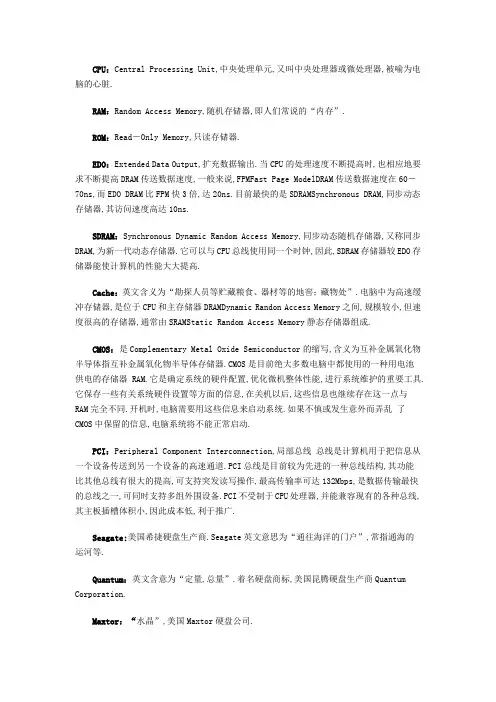
CPU:Central Processing Unit,中央处理单元,又叫中央处理器或微处理器,被喻为电脑的心脏.RAM:Random Access Memory,随机存储器,即人们常说的“内存”.ROM:Read-Only Memory,只读存储器.EDO:Extended Data Output,扩充数据输出.当CPU的处理速度不断提高时,也相应地要求不断提高DRAM传送数据速度,一般来说,FPMFast Page ModelDRAM传送数据速度在60-70ns,而EDO DRAM比FPM快3倍,达20ns.目前最快的是SDRAMSynchronous DRAM,同步动态存储器,其访问速度高达10ns.SDRAM:Synchronous Dynamic Random Access Memory,同步动态随机存储器,又称同步DRAM,为新一代动态存储器.它可以与CPU总线使用同一个时钟,因此,SDRAM存储器较EDO存储器能使计算机的性能大大提高.Cache:英文含义为“勘探人员等贮藏粮食、器材等的地窖;藏物处”.电脑中为高速缓冲存储器,是位于CPU和主存储器DRAMDynamic Randon Access Memory之间,规模较小,但速度很高的存储器,通常由SRAMStatic Random Access Memory静态存储器组成.CMOS:是Complementary Metal Oxide Semiconductor的缩写,含义为互补金属氧化物半导体指互补金属氧化物半导体存储器.CMOS是目前绝大多数电脑中都使用的一种用电池供电的存储器RAM.它是确定系统的硬件配置,优化微机整体性能,进行系统维护的重要工具.它保存一些有关系统硬件设置等方面的信息,在关机以后,这些信息也继续存在这一点与RAM完全不同.开机时,电脑需要用这些信息来启动系统.如果不慎或发生意外而弄乱了CMOS中保留的信息,电脑系统将不能正常启动.PCI:Peripheral Component Interconnection,局部总线总线是计算机用于把信息从一个设备传送到另一个设备的高速通道.PCI总线是目前较为先进的一种总线结构,其功能比其他总线有很大的提高,可支持突发读写操作,最高传输率可达132Mbps,是数据传输最快的总线之一,可同时支持多组外围设备.PCI不受制于CPU处理器,并能兼容现有的各种总线,其主板插槽体积小,因此成本低,利于推广.Seagate:美国希捷硬盘生产商.Seagate英文意思为“通往海洋的门户”,常指通海的运河等.Quantum:英文含意为“定量,总量”.着名硬盘商标,美国昆腾硬盘生产商Quantum Corporation.Maxtor:“水晶”,美国Maxtor硬盘公司.LD:Laser Disk,镭射光盘,又称激光视盘.CD:Compact Disc,压缩光盘,又称激光唱盘.CD-ROM:Compact Disc-Read Only Memory,压缩光盘-只读记忆存储,又叫“只读光盘”.VCD:Video Compact Disc,视频压缩光盘,即人们通常所说的“小影碟”.DVD:至今有许多人把DVD视为Digital Video Disc数字视频光盘的缩写,事实上,从1995年9月,索尼/飞利浦和东芝/时代华纳两大DVD开发集团达成DVD统一标准后,DVD的内涵有了很大的变化,它已成了数字通用光盘,即Digital Versatile Disc的英文缩写.Versatile“通用”的含义表明了DVD用途的多元化,它不仅可用于影视娱乐,还可用于多媒体计算机等领域.目前按其用途可分为5种类型:1计算机用只读光盘——DVD-ROM;2家用型影音光盘——DVD-Movie;3专供音乐欣赏的DVD Audio;4只写一次的光盘——DVD-R;5可读写多次的光盘——DVD-RAM.Modem:调制解调器,家用电脑上Internet国际互联网网的必备工具,在一般英汉字典中是查不到Modem这个词的,它是调制器MOdulator与解调器DEModulator的缩写形式.Modem 是实现计算机通信的一种必不可少的外部设备.因为计算机的数据是数字信号,欲将其通过传输线路例如电话线传送到远距离处的另一台计算机或其它终端如电传打字机等,必须将数字信号转换成适合于传输的模拟信号调制信号.在接收端又要将接收到的模拟信号恢复成原来的数字信号,这就需要利用调制解调器.UPS:为Uninterruptible Power Supply不间断电源的英文缩写.它是伴随着计算机的诞生而出现的,是电脑的重要外围设备之一.UPS是一种含有储能装置,以逆变器为主要组成的恒压恒频的不间断电源,用以保护电脑在突然断电时不会丢失重要的数据.TFT:有源矩阵彩色显示器,简称TFT显示器,专用于笔记本电脑.TFT显示器具有刷新速度快、色彩逼真、亮度鲜明等优点.此外,它还具有无闪烁、无辐射、无静电等“绿色电脑”所必需的特点.。
access 访问address 地址address bus 地址总线address decoder 地址译码器address register (AR) 地址寄存器addressing mode 寻址方式American standard code for information interchange (ASCII) 美国标准信息交换码analog-digital conversion(ADC) 模数转换arbiter 仲裁机构arithmetic logical unit (ALU) 算术逻辑单元assembler 汇编auxiliary storage 辅助存储器binary 二进制binary coded decimal(BCD) 二进制编码的十进制数bit 位block carry look ahead (BCLA) 成组先行进位电路buffer 缓冲bus 总线byte 字节cache 高速缓冲存储器carry generate function 进位产生函数carry propagate function 进位传递函数cathode ray tube (CRT) 阴极射线管central process unit(CPU) 中央处理器channel 通道charge couple device (CCD) 电荷耦合器件compact disc read only memory (CD-ROM) 只读光盘compiler 编译程序complex instruction set computer (CISC) 复杂指令系统计算机computer aided design(CAD) 计算机辅助设计computer aided instruction (CAI) 计算机辅助教学computer aided manufacturing(CAM)计算机辅助制造computer aided test(CAT) 计算机辅助测试computer organization 计算机组成controller 控制器coprocessor 协处理器cyclic redundancy code (CRC) 循环冗余校验码data bus 数据总线data register (DR) 数据寄存器database management system (DBMS) 数据库管理系统database 数据库decimal 十进制deflection coil 偏转线圈desktop computer 台式计算机destination operand 目的操作数digital camera 数字照相机digital-analog conversion (DAC) 数模转换direct memory access (DMA) 直接存储器存取display 显示器dot pitch 点距dots per inch (dpi) 每英寸点数dynamic random access memory (DRAM) 动态随机存储器effective address (EA) 有效地址electrically erasable programmable read only memory(EEPROM) 电擦除可编程只读存储器electronic design automation (EDA) 电子设计自动化erasable programmable read only memory (EPROM) 可擦编程只读存储器even parity 奇校验excess-3 code 余3 码expansion bus speed 扩展总线速度exponent 阶码extended industry standard architecture (EISA) 扩展工业标准结构firmware 固件fixed point numbers 定点数flag register (FR) 标志寄存器floating point numbers 浮点数flow chart 流程图flyback transformer 回转变压器full adder (FA) 全加器general register (GR) 通用寄存器general-purpose computer 通用计算机gray code 格雷码hardware 硬件hexadecimal 十六进制immediate operand 立即数industrial standard architecture(ISA) 工业标准总线ink-jet printer 喷墨打印机input 输入input device 输入设备instruction 指令instruction cycle 指令周期instruction decoder (ID) 指令译码器instruction register(IR) 指令寄存器instruction set 指令系统interface 接口interpreter 解释程序interrupt 中断interrupt flip-flop 中断触发器interrupt mask register (IMR) 中断屏蔽寄存器interrupt priority level 中断优先级interrupt request register (IRR) 中断请求寄存器interrupt response 中断响应interrupt service register (ISR) 中断服务寄存器interrupt source 中断源keyboard 键盘large scale integration (LSI)大规模集成电路laser printer 激光打印机last in first out (LIFO) 后进先出least recently used(LRU) 近期最少使用(算法)light emitting diode (LED) 发光二极管liquid crystal display (LCD) 液晶显示器machine instruction 机器指令machine language 机器语言magnetic disk 磁盘mainframe 大型机,主机mantissa 尾数mean time between failures (MTBF) 平均无故障时间memory 存储器memory bus speed 内存总线速度memory location 存储单元memory management unit (MMU) 存储器管理单元memory size 存储容量microcomputer 微型机microinstruction 微指令microprocessor 微处理器microprogram 微程序million floating point operations per second (MFLOPS) 每秒百万次浮点运算million instructions per second (MIPS) 每秒百万条指令minicomputer 小型机mnemonics 助记符model 模monochrome monitor 单色显示器mouse 鼠标notebook 笔记本object program 目标程序octal 八进制odd parity 偶校验one’s complement 反码operating system (OS) 操作系统operation code (OP) 操作码operand 操作数optical character reader (OCR) 光学字符阅读机optical disk 光盘output 输出output device 输出设备overflow 溢出paged virtual memory 页式虚拟存储器peripheral component interconnect(PCI) 外围设备互联peripheral device 外围设备personal computer (PC) 个人计算机personal digital assistant (PDA) 个人数字助理pipeline 流水线plasma display panel(PDP) 等离子显示器pop 出栈printer 打印机priority 优先权program counter 程序计数器program status word (PSW) 程序状态字寄存器programmable read only memory (PROM) 可编程序的只读存储器programming 程序设计push 进栈random access memory (RAM) 随机存储器read only memory (ROM) 只读存储器reduced instruction set computer (RISC) 精简指令系统refresh 刷新register 寄存器scanner 扫描仪sector 扇区segment virtual memory 段式虚拟存储器shadow masks 点状阴罩software 软件source operand 源操作数source program 源程序special purpose computer 专业计算机stack 堆栈stack pointer (SP) 堆栈指针static random access memory (SRAM) 静态随机存储器string 字符串stylus printer 针式打印机supercomputer 巨型机supply voltage 工作电压track 磁道trigger 触发器true value 真值complementary code 补码very large scale integration(VLSI) 超大规模集成电路virtual memory 虚拟存储器word length 字长work station 工作站write once read many (WORM) 只写一次型(光盘)。
Introductions of PLC and MCUA PLC is a device that was invented to replace the necessary sequential relay circuits for machine control. The PLC works by looking at its inputs and depending upon their state, turning on/off its outputs .The user enters a program, usually via software or programmer that gives the desired results.PLC are used in many “real world” applications. If there is industry present, chances are good that there is a PLC present. If you are involved in machining, packaging, material handling, automated assembly or countless other industries, you are probably already using them. If you are not, you are wasting money and time. Almost any application that needs some type of electrical control has need for PLC.For example, let’s assume that when a switch turns on we want to turn a solenoid on for 5 seconds and then turn it off regardless of how long the switch is on for. We can do this with a simple external timer. What if the process also needed to count how many times the switch individually turned on? We need a lot of external counters.As you can see, the bigger the process the more of a need we have for a PLC. We can simply program the PLC to count its inputs and turn the solenoids on for the specified time.We will take a look at what i s considered to be the “top 20” PLC instructions. It can be safely estimated that with a firm understanding of there instructions one can solve more than 80% of the applications in existence.That‘s right, more than 80%! Of course we’ll learn more than jus t these instructions to help you solve almost ALL your potential PLC applications.The PLC mainly consists of a CPU, memory areas, and appropriate circuits to receive input/output data, as shown in Fig. 19.1 We can actually consider the PLC to be a box full of hundreds or thousands of separate relays, counters, timer and date storage locations. Do these counters, timers, etc. really exist? No, they don’t “physically” exist but rather they are simulated and can be considered software counters, timers, etc. These internal relays are simulated through bit locations in registers.What does each part do?INPUT RELAYS-(contacts) These are connected to the outside world. They physically exist and receive signals from switches, sensors, etc... Typically they are not relays but rather they are transistors.INTERNAL UTILITY RELAYS-(contacts) These do not receive signals from the outside world nor do they physically exist. They are simulated relays and are what enables a PLC to eliminate external relays. There are also some special relays that are dedicated to performing only one task. Some are always on while some are always off. Some are on only once during power-on and are typically user for initializing data what was stored.COUNTERS These again do not physically exist. They are simulated counters and they can be programmed to count pulses. Typically these counters can count up, down or both up and down. Since there are simulated, they are limited in their counting speed. Some manufacturers also include high-speed counters that are hardware based. We can think of these as physically existing. Most timers these counters can count up, down or up and down.TIMERS These also do not physically exist. They come in many varieties and increments. The most common type is an on-delay type. Other include off-delay and both retentive and non-retentive types. Increments vary from 1ms through 1s.OUTPUT RELAYS-(coil) These are connected to the outside world. They physically exist and send on/off signals to solenoids, lights, etc… They can be transistors, relays, or triacs depending upon the model chosen.DATA STORAGE-Typically there are registers assigned to simply store data. There are usually used as temporary storage for math or data manipulation. They can also typically be user power-up they will still have the same contents as before power war removed. Very convenient and necessary!A PLC works by continually scanning a program. We can think of this scan cycle as consisting of 3 important steps, as shown in Fig.19.2 There are typically more than 3 but we can focus on the important parts and not worry about the others. Typically the others are checking the system and updating the current and timer values.Step 1-CHECK INPUT STATUS-First the PLC takes a look at each input to determine if it is on or off. In other words, is the sensor connected to the first input on? How about the second input? How about the third…It records this data into its memory to be used during the next step.Step 2-EXECUTE PROGRAM-Next the PLC executes your program one instruction at a time. Maybe your program said that if the first input was on then it should turn on the first output. Since is already knows which inputs are on/off from the previous step, it will be able to decide whether the first output should be turned onbased on the state of the first input. It will store the execution results for use later during the next step.Step 3-UPDATE OUTPUT STSTUS-Finally the PLC updates the status of outputs. It updates the outputs based on which inputs were on during the first step and the results of executing your program during the second step. Based on the example in step 2 it would now turn on the first output because the first input was on and your program said to turn on the first output when this condition is true.After the third step the PLC goes back to step one and repeats the steps continuously. One scan time is defined as the time is takes to execute the 3 steps listed above. Thus a practical system is controlled to perform specified operations as desired.The AT89S52 is a low-power, high-performance CMOS 8-bit microcontroller with 8Kbytes of in-system programmable Flash memory. The device is manufactured using Atmel’s high-density nonvolatile memory technology and is compatible with the industry-standard 80C51 instruction set and pin-out. The on-chip Flash allows the program memory to be reprogrammed in-system or by a conventional nonvolatile memory programmer. By combining a versatile 8-bit CPU with in-system programmable Flash on a monolithic chip, the Atmel AT89S52 is a powerful microcontroller which provides a highly-flexible and cost-effective solution to many embedded control applications.The AT89S52 provides the following standard features: 8K bytes of Flash, 256 bytes of RAM, 32 I/O lines, Watchdog timer, two data pointers, three 16-bit timer/counters, a six-vector two-level interrupt architecture, a full duplex serial port, on-chip oscillator, and clock circuitry. In addition, the AT89S52 is designed with static logic for operation down to zero frequency and supports two software selectable power saving modes. The Idle Mode stops the CPU while allowing the RAM, timer/counters, serial port, and interrupt system to continue functioning. The Power-down mode saves the RAM contents but freezes the oscillator, disabling all other chip functions until the next interrupt or hardware reset.Port 0 is an 8-bit open drain bidirectional I/O port. As an output port, each pin can sink eight TTL inputs. When is written to port 0 pins, the pins can be used as high-impedance inputs.Port 0 can also be configured to be the multiplexed lowered address/data bus during accesses to external program and data memory. In this mode, P0 has internal pull-ups.Port 0 also receives the code bytes during Flash programming and outputs the code bytes during program verification. External pull-ups are required during program verification.Port 1 is an 8-bit bidirectional I/O port with internal pullups.The Port 1 output buffers can sink/source four TTL inputs. When 1s are written to Port 1 pins, they are pulled high by the internal pull-ups and can be used as inputs. As inputs, Port 1 pins that are externally being pulled low will source current (I IL) because of the internal pull-ups.In addition, P1.0 and P1.1 can be configured to be the timer/counter 2 external count input (P1.0/T2) and the timer/counter 2 trigger input (P1.1/T2EX).PLC和微处理器简介PLC(可编程逻辑控制器)是极限控制中为代替必要的继电器时序电路而发明的一种设备。
processor name 英译汉-回复Processor name,即处理器名字(也称为中央处理器名称),是指计算机处理器的标识符或标签。
处理器名称通常由处理器制造商为其产品指定,用于识别该处理器型号或系列。
本文将一步一步回答有关处理器名字的相关问题。
在计算机科学领域,处理器名称承载着很重要的信息,它可以告诉我们处理器的型号、制造商、架构和特定功能。
处理器名称通常由几个部分组成,每个部分都有特定的含义。
下面将介绍一些常用的处理器名称部分:1. 制造商:处理器名称通常以制造商的名字作为开头。
例如,英特尔(Intel)处理器通常以“Intel”开头,而AMD(Advanced Micro Devices)处理器通常以“AMD”开头。
制造商的名字可以帮助我们快速了解处理器的来源和品牌。
2. 型号:型号是处理器名称中的另一个重要部分,它指定了处理器的具体型号或系列。
不同的型号通常有不同的性能特性和功能。
例如,英特尔的Core i5和AMD的Ryzen 7就是不同型号的处理器。
3. 架构:处理器的架构指的是处理器的内部设计和组织方式。
不同的架构会影响处理器的性能和功耗。
常见的处理器架构包括x86、ARM和PowerPC。
处理器名称中可能包含有关架构的信息,比如英特尔的第八代酷睿处理器(Intel Core i7 8th Gen)。
4. 频率:处理器的频率表示处理器每秒钟执行的指令数量。
频率通常以赫兹(Hz)为单位表示。
更高的频率通常意味着更快的处理速度。
处理器名称中可能会包含有关频率的信息,比如英特尔酷睿i7-10700K(Intel Core i7-10700K)。
5. 特定功能:一些处理器名称还可能包含有关特定功能或技术的信息。
例如,英特尔的超线程技术可以同时处理多个线程,这在处理器名称中通常会有所体现,比如Intel Core i7-10700K。
处理器名称不仅仅是一串字母和数字的组合,它代表着处理器的性能和功能。
计算机cpu英语作文English Version:Title: The Heart of the Computer: The CPUThe Central Processing Unit (CPU), often referred to as the brain of the computer, is the primary component responsible for executing instructions and processing data in a computer system. It is the heart that pumps life into the digital world, enabling the seamless functioning of software applications and operating systems.At the core of the CPU lies its architecture, which consists of the control unit, arithmetic logic unit, and registers, all of which work in unison to perform complex calculations and logical operations. The CPU's speed, measured in gigahertz (GHz), determines how quickly it can process information, with higher frequencies correlating to faster processing times.One of the most significant advancements in CPU technology is the concept of multi-core processing. Modern CPUs often feature multiple processing cores, allowing for parallel computing and enhanced performance. This technology has revolutionized the way computers handle multitasking and run resource-intensive applications.Another critical aspect of the CPU is its compatibility with the motherboard and other system components. Ensuring that the CPU is compatible with the system's architecture is essential for optimal performance and to avoid bottlenecks that can hinder the computer's overall efficiency.Moreover, the power consumption and heat generation of a CPU are also areas of concern. As CPUs become more powerful, they also generate more heat, which necessitates efficient cooling solutions to maintain stable operation and prevent damage to the processor.In conclusion, the CPU is an indispensable component of any computer system. Its continuous evolution drives the advancement of computing capabilities, allowing us to perform tasks that were once deemed impossible. Understanding the CPU's role and its impact on system performance is crucial for anyone looking to optimize or build a computer.Chinese Translation:标题:计算机的核心:CPU中央处理器(CPU)常被称为计算机的大脑,是负责执行指令和处理计算机系统中数据的主要组件。
介绍你的配置英文作文Title: Introduction to My Configuration。
In this essay, I will provide an overview of my configuration, detailing the specifications and features of my setup. From hardware to software, I will delve into the components that make up my personalized computing environment.Hardware Configuration:1. Central Processing Unit (CPU): I have opted for a high-performance CPU to ensure smooth multitasking and efficient processing of tasks. The CPU is the brain of my system, responsible for executing instructions and powering the various applications I use.2. Graphics Processing Unit (GPU): A powerful GPU is essential for tasks such as gaming, video editing, and graphic design. I have chosen a GPU that offers excellentperformance and rendering capabilities to meet my needs.3. Random Access Memory (RAM): Ample RAM is crucial for multitasking and running memory-intensive applications smoothly. I have installed a sufficient amount of RAM to ensure optimal performance and responsiveness.4. Storage: For storage, I utilize a combination of solid-state drives (SSDs) and hard disk drives (HDDs). SSDs provide fast read and write speeds, ideal for storing frequently accessed files and operating system installations, while HDDs offer larger storage capacities for less frequently accessed data.5. Motherboard: The motherboard serves as the backbone of my system, providing connectivity and housing essential components such as the CPU, RAM, and GPU. I have chosen a motherboard that offers robust features and compatibility with my chosen hardware.6. Peripherals: I have selected high-quality peripherals such as a keyboard, mouse, and monitor tocomplement my setup. These peripherals enhance my user experience and facilitate efficient interaction with my computer.Software Configuration:1. Operating System (OS): I have opted for an operating system that aligns with my preferences and workflow requirements. The OS serves as the foundation of my computing environment, providing a platform for running applications and managing system resources.2. Productivity Software: To enhance my productivity, I utilize a suite of software applications for tasks such as word processing, spreadsheet management, and presentation creation. These tools enable me to effectively manage projects, collaborate with others, and organize information.3. Creative Software: As a creative individual, I rely on specialized software for tasks such as graphic design, photo editing, and video production. These tools empower me to express my creativity and bring my ideas to life throughdigital media.4. Security Software: Protecting my system and data is paramount, so I employ security software to safeguard against malware, viruses, and other cyber threats. These tools provide real-time protection and help ensure the integrity and confidentiality of my information.5. Utilities: I utilize various utility software to optimize system performance, manage files, and customize my computing environment. These utilities streamline routine tasks and enhance the overall usability of my system.In conclusion, my configuration encompasses a blend of high-performance hardware and versatile software tailored to meet my computing needs. By carefully selecting and configuring each component, I have created a personalized environment that empowers me to work efficiently, express my creativity, and stay secure in the digital realm.。
原文出处:Madden S,Frankin M,Hellerstein J,et al.TinyDB:an acquisitional query processing system for sensor networks.中央处理器设计摘要CPU(中央处理单元)是数字计算机的重要组成部分,其目的是对从内存中接收的指令进行译码,同时对存储于内部寄存器、存储器或输入输出接口单元的数据执行传输、算术运算、逻辑运算以及控制操作。
在外部,CPU为转换指令数据和控制信息提供一个或多个总线并从组件连接到它。
在通用计算机开始的第一章,CPU作为处理器的一部分被屏蔽了。
但是CPU有可能出现在很多电脑之间,小,相对简单的所谓微控制器的计算机被用在电脑和其他数字化系统中,以执行限制或专门任务。
例如,一个微控制器出现在普通电脑的键盘和检测器中,但是这些组件也被屏蔽。
在这种微控制器中,与我们在这一章中所讨论的CPU可能十分不同。
字长也许更短,(或者说4或8个字节),编制数量少,指令集有限。
相对而言,性能差,但对完成任务来说足够了。
最重要的是它的微控制器的成本很低,符合成本效益。
在接下去的几页里,我考虑的是两个计算机的CPU,一个是一个复杂指令集计算机( CISC),另一个是精简指令集计算机(RISC)。
在详细的设计检查之后,我们比较了两个CPU的性能,并提交了用来提高性能的一些方法的简要概述。
最后,我们讨论了关于一般数字系统设计的设计思路。
1.双CPU的设计正如我们前一章提到的,一个典型的CPU通常被分成两部分:数据路径和控制单元。
该数据路径由一个功能单元、登记册和内部总线组成,为在功能单元、存储器以及其他计算机组件之间提供转移信息的途径。
这个数据途径有可能是流水线,也有可能不是。
控制单元由一个程序计数器,一个指令寄存器,控制逻辑,和可能有其他硬或微程序组成。
如果数据途径是流水线那么控制单元也有可能是流水线。
电脑的CPU是一个部分,要么是复杂指令集计算机( CISC),要么是精简指令集计算机(RISC),有自己的指令集架构。
本章的目的是提交两个CPU的设计,用来说明指令集,数据路径,和控制单元的构造特征的合并。
该设计将自上而下,但随着先前组件设计的重新使用,来说明指令集构架在数据路径和控制单元上的影响,数据路径上的单元的影响力。
这些材料广泛使用了表格和图表。
虽然我们重用和改变部分来自其他国家的设计,其他章节的背景信息,此处不再重复。
但是,参考资料可以在这本书的前几节里找到详细的信息。
这两个CPU是为了一个带有微程序控制单元的使用非流水线数据路径的复杂指令集计算机( CISC)和一个带有硬控制单元的使用流水线数据路径的精简指令集计算机(RISC)而提出的。
这些是两个截然不同指令集架构,数据路径和控制单元的组合。
2.复杂指令集计算机我们提交的第一个设计就是为一个带有非流水线数据路径和微程序的控制单元的复杂指令集计算机而设计的。
我们以介绍指令集构架为开端,它包括CPU的注册设置,教学形式,和处理方式。
复杂指令集计算机( CISC)的指令集构架的性质是通过它的内存到内存进行数据存取操作指示8个处理模式,两长指令格式和指令集,来为它们的执行获得重要的运行序列。
我们为实施复杂指令集计算机( CISC)构架而设计一个数据路径。
这个数据路径是基于最初描述的7-9节里,并纳入了8-10节里的CPU中。
对登记档案,功能单元以及总线进行修改来支持现有的指令集构架。
一旦数据路径被明确,被设计的一个控制单元就去完成指令集构架的执行。
控制单元的设计必须涉及硬件组织和微程序组织的一个协调的定义。
特别是把微程序分成微线路,然而同时也设计了它们相互影响的音序器,这是设计的关键部分。
即使是指令集领域和有联系的同代码的这种协调一致的努力。
以下是硬件和微代码组织的定义,我们详细描述的是为运行代表的微型代码个微型线路的基本部分。
2.1指令集构架图1显示了程序员获得的一套复杂指令集计算机( CISC)的寄存器。
所有的注册有16位。
这个注册文件有8个寄存器,从R0到R7。
R0是一个寄存器,当它被作为目的来使用,作为来源和抛弃的结果来使用时她总是提供零价值。
除了注册文件,还有一个程序计数器pc和堆栈指针SP。
堆栈指针的出现的情况表明内存堆栈是构架的一部分。
最后登记的是处理器状态寄存器PSR,它包括最右边的五个位的信息;剩下的都被假定包含0.该处理器状态寄存器包含四个存储状态位值Z,N,C,和V,他们分别位于0-3之间。
另外,一个存储中断使得EI处在4的位置上。
图1包含了42个通过指令集进行的操作。
每个操作都一个记忆和精心挑选的同位代码。
根据一些明确的操作和是否分开操作,将这些操作分成4组。
另外,这些状态位受到被列开的操作的影响。
图1图2给出了CPU的指令格式。
通用指令格式的有五个领域。
首先,OPCODE是指定的操作。
接下去的两个是MODE 和 S,是被用来确定运算的地址。
最后两个领域是SRC和DST,分别是3位的来源登记和目的地登记领域。
此外,还有一个可选的第二个字母W,随着一些作为一个操作或一个地址的指示而出现的,而不是随着其他出现的。
图2OPCODE的前两位,IR(15:14),确定了一些明确的操作和格式领域的如何使用。
当这些位是00时,要么是没有被要求的操作要么是被OPCODE隐含的操作的位置。
正如图2(b)显示的,只有OPCODE领域的是需要的。
右边的4个OPCODE位可以指定多达16个操作或带有暗示的操作地址。
如果IR是(15:14)是01,指令有一个操作,且是数据传输或数据操作指令。
因为有了一个操作,MODE领域就会为获得它而指定处理方式。
单处理可能会涉及DST格式里的注册地址,所以DST领域也会被引出。
S领域和SRC领域涉及到两个运算的同时出现,因此不被用于典型的单一的操作指示。
但是,切换指令要求有一个切换数额来只是到底切换多少位。
为获得最大的灵活性,这个切换数额是只针对像来源运算一样的的运算。
因此,SAH领域和S领域是一个完整的16位运算,但它们的值只有0-15是有意义的。
对带有单一运算的16位指令来说有足够的OPCODE位。
图2给出了指定通过MODE领域的处理方式。
MODE的前两位指定了4中不同的处理类型:注册、立即、索引以及相关的程序计数器PC。
MODE的第三位明确是否地址是通过这些被用作间接处理的模式而形成。
一个例外就是直接处理,它是通过运用间接立即类型而获得的。
否则,如果第三位等于0的,间接处理就不适用,而如果等于1 ,间接处理就适用。
对指令的注册类型来说,MONE(2:1)=00和这个W字母是不需要的。
因为运算或处理是来自注册。
表格的第三栏提供了注册转换为针对一个操作指令的每个处理模式的声明。
如果IR(15:14) 等于10,然后有两个地址被用来正确的指令。
通用指令的所有领域,其中包括S和SRC,被用于为所有指令的案件。
其中一个地址,无论是来源或目的地,都使用处理模式。
如果S等于0,那么来源使用被MODE指定的处理模式,且来源是注册的。
如果S等于1那么目的地使用处理方式,且来源是注册的。
注册转换为处理结果的描述在在表2第四次和第五次栏已给出了。
此外,根据MODE领域的内容,第二个指令字母W是一个地址或立即操作,有可能存在,也有可能不存在。
带有IR(15:14)=11的指令是分流的。
对切换来说除了S领域和SHA领域,它的格式和IR(15:14)=01一样的。
对于这个类型的所有指令,目的地的地址(而不是操作)成为新的地址放置程序计数器PC里。
因此,注册模式对分支指令是无效的。
在进行下一步之前,明确数据路径来支持指令集构架,我们将简要的说明构架的特征来界定是复杂指令集计算机( CISC)或是精简指令集计算机(RISC)。
在第9章里给出的大部分操作都被包括在指令集里。
一些不会显示的操作是多余的。
同样的动作可以通过使用带有显示指令的适当的处理模式来实现。
例如,LD, ST, IN, 和 OUT都可以通过使用在内存映射结构里的MOVE指令来实现。
通过查看指令的格式,我们发现大部分指令可以从来自内存的操作上进行直接操作。
有8个处理模式和两种不同长度的指令格式。
此外,有些的指示执行复杂的行动可被视为很可能会超过一个时钟周期执行的步骤的行动。
这些特征明确指出这是一个复杂指令集计算机( CISC)的架构。
2.2数据路径组织不是从头开始,我们将重新使用非流水线数据路径被雇用在第8-10节里的微程序控制器,并进行修改。
该数据路径显示在第8-10节,和新的数据路径,是给出的图10-6的基础上进行修改的。
我们对待每个反复修改的数据路径,都是以注册文件为开端的。
在第8-10节里,注册R8是被作为临时的存储位置。
在新的微程序的架构,有复杂的指示要跨越许多时钟周期和执行复杂的动作。
因此,更多的临时存储需要通过微程序来使用。
为了满足这个需要,我们扩展了注册文件从9登记到16.前8个登记,R0-R7,对计算机程序员来说是可见的。
接下去的8个登记,R8-R15,是被用来作为微程序的临时存储,并从程序员那就被隐藏。
图3提供了一个带有临时登记屏蔽的扩展注册文件的地图。
如前所述,编程R0提供的是一个常数0.编程R1到R7可提供给程序员使用,编程R8到R15提供通用的临时存储被微程序使用,最后4个编程,R12到R15具有特殊的用途:保持简单的微型代码,标准的位置对存储的操作和被为大多数指令而执行的微代码所使用的地址来说是必不可少的。
因此,R12是源地址SA,R13是源数据SD,R14是目的地地址DA,R15是目的地数据DD。
我们不能进入8个基于在指令集内可用3位登记地址的临时登记册。
为了解决这个问题,首先,我们提供了来自微指令的4位注册地址,其次,选择来自这些地址和微指令集的指令之间的微指令位。
此外,允许注册地址的灵活性通过DST成为来源和通过SRC 成为目的地,他们是需要操作结果的允可来直接存放在内存中。
为了完成这个目标,我们通过增加图4所示的逻辑来修改登记档案。
该指令集架构使用两个地址,一个图3是来源操作,一个是像目的地一样的其他来源。
该登记册档案使用B地址的来源,以及A和D处理的文件连接在一起,从而使其他来源和目的地使用同一个地址。
虽然在微指令水平上的地址从3个减少到2个是没必要的,但对在微指令中的注册地址和指令格式中的匹配使用的登记领域的位的数量的减少还是必要的。
一个四倍的2比1的多路复用器附属在两个地址一个一个的输入到注册文件中,在来自微指令的地址和指令的地址之间进行选择。
在微指令中有5位的空间是用来合并目的地和来源地址的DSA,再增加5位空间给B地址SB。
每个领域的第一个位是在微指令(0)中的登记地址和指令(0)中的登记地址之间进行选择的。